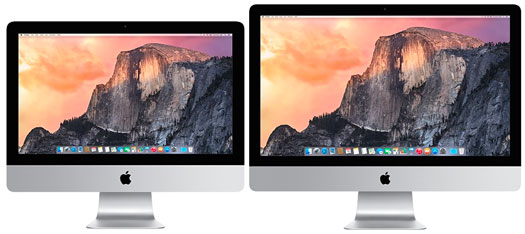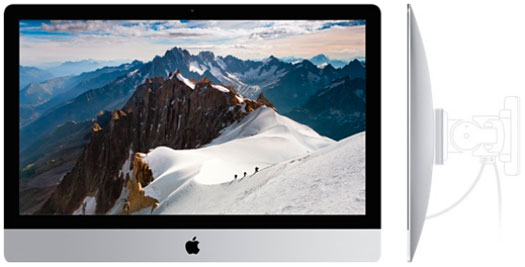Hosted by site sponsor WebMate.
"Tapered Edge" Aluminum iMac Q&A
Update Published August 20, 2020
All Mac Q&As >> "Tapered Edge" Aluminum iMac Q&A (Home)
To be notified of new Q&As, sign up for EveryMac.com's bimonthly email list.
What are the differences between the displays used in the "Tapered Edge" Aluminum iMac models?
All "Tapered Edge" Aluminum iMac models -- regardless of series -- have an LED-backlit 16:9 widescreen TFT active matrix display with IPS technology, but the dimensions and native resolutions are different.

Photo Credit: Apple, Inc. (21.5" & 27" Tapered Edge iMac, Left & Right, Respectively)
Specifically, all of the pre-"Late 2015" 21.5-Inch models have a native resolution of 1920x1080, whereas the non-Retina 27-Inch models have a native resolution of 2560x1440. The "Retina 4K" 21.5-Inch models have a native resolution of 4096x2304 and the "Retina 5K" models have a native resolution of 5120x2880.
However, by default, the Retina 4K models run "pixel doubled" at 2048x1152 and the Retina 5K models likewise run at a resolution that looks like 2560x1440. However, these "pixel doubled" settings look significantly sharper than earlier displays at the same resolution.
It also is worth noting that the "Mid-2017" and "2019" Retina 4K and Retina 5K models are brighter than the displays in previous models with a brightness rating of 500 nits and support for wide color (DCI-P3). They support one billion colors.
Apple reports that the "cover glass is fully laminated to the LCD and an anti-reflective coating is applied" for all of these models, too.
What type of video processor is provided by the "Tapered Edge" Aluminum iMac systems? Which have dedicated memory? Which have integrated memory?
The education-only iMac "Core i3" 3.3 21.5-Inch (Early 2013) as well as a variety of subsequent models have cheaper "integrated" graphics that "borrow" memory from the system. Other models have "dedicated" video memory.
However, the integrated video solutions vary significantly as do the dedicated video options.
Specifically, these models have integrated memory and are best to be avoided by those who place maximum importance on video performance:
Tapered Edge Aluminum iMac |
Integrated Video Processor |
HD Graphics 4000 |
|
Iris Pro 5200 |
|
HD Graphics 5000 |
|
HD Graphics 6000 |
|
Iris Pro 6200 |
|
Iris Pro 6200 |
|
Iris Plus Graphics 640 |
The below models have dedicated video memory and generally provide better graphics performance than systems with integrated memory released at the same time:
Tapered Edge Aluminum iMac |
Dedicated Video Processor |
512 MB GeForce GT 640M |
|
512 MB GeForce GT 650M |
|
512 MB GeForce GT 650M |
|
512 MB GeForce GTX 660M |
|
1 GB GeForce GTX 675MX |
|
1 GB GeForce GTX 675MX |
|
1 GB GeForce GT 750M |
|
1 GB GeForce GT 750M |
|
1 GB GeForce GT 755M |
|
2 GB GeForce GTX 775M |
|
2 GB GeForce GTX 775M |
|
2 GB Radeon R9 M290X |
|
2 GB Radeon R9 M290X |
|
2 GB Radeon R9 M290 |
|
2 GB Radeon R9 M380/M390 |
|
2 GB Radeon R9 M395 |
|
2 GB Radeon Pro 555 |
|
4 GB Radeon Pro 560 |
|
2, 4 GB Radeon Pro 555/560 |
|
4 GB Radeon Pro 570 |
|
4 GB Radeon Pro 575 |
|
8 GB Radeon Pro 580 |
|
4, 8 GB Radeon Pro 575/580 |
|
2 GB Radeon Pro 555X |
|
4 GB Radeon Pro 560X/Vega 20 |
|
2, 4 GB Radeon Pro 555X/560X/Vega 20 |
|
4 GB Radeon Pro 570X |
|
4 GB Radeon Pro 575X |
|
8 GB Radeon Pro 580X/Vega 48 |
|
4, 8 GB Radeon Pro 575X/580X/Vega 48 |
|
4 GB Radeon Pro 5300 |
|
| 4 GB Radeon Pro 5300 | |
8 GB Radeon Pro 5500 XT |
|
4, 8 GB Radeon Pro 5300/5500 XT |
|
8, 16 GB Radeon Pro 5700/5700 XT |
|
8, 16 GB Radeon Pro 5700/5700 XT |
The video processor is affixed in place and cannot be upgraded on any of the "Tapered Edge" Aluminum iMac models after purchase.
Do the "Tapered Edge" Aluminum iMac models support multiple displays? What is the maximum resolution for an external display?
Yes, all "Tapered Edge" Aluminum iMac models support multiple displays in addition to simultaneous support of the internal display at its native resolution.
Specifically, all pre-Retina "Tapered Edge" iMac models -- the Late 2012, Early 2013, Late 2013, and Mid-2014 lines -- support two external displays up to 2560x1600 via Thunderbolt.
The Late 2014/Mid-2015 Retina/5K models -- the iMac "Core i5" 3.5 27" (Late 2014), "Core i7" 4.0 27" (Late 2014) and "Core i5" 3.3 27" (Mid-2015) -- formally support a single external 3840x2160 (4K UltraHD) display via Thunderbolt 2. However, third-parties have discovered that these models also can support two simultaneous 27-Inch Thunderbolt displays at 2560x1140 each instead of a single 4K UltraHD display.
The entry-level 21.5-Inch "Late 2015" iMac -- the iMac "Core i5" 1.6 21.5-Inch -- supports a single external display up to 3840x2160 resolution whereas the other 21.5-Inch "Late 2015" models support a single external display up to 4096x2304. The 27-Inch "Late 2015" iMac models, on the other hand, support a single external 5120x2880 dual-cable external display or two external 4096x2160 displays.
All "Mid-2017" and "2019" iMac models, regardless of display size, support one 5120x2880 (5K) external display at 60 Hz with support for one billion colors; two 3840x2160 (4K UHD) external displays at 60 Hz with support for one billion colors; or two 4096x2304 (4K) external displays at 60 Hz with support for millions of colors.
The 27-Inch "2020" iMac models support up to one 6016x3384 (6K) external display at 60 Hz with support for 1 billion colors; one 5120x2880 (5K) external display at 60 Hz with support for 1 billion colors; two 3840x2160 (4K UHD) external displays at 60 Hz with support for 1 billion colors; or two 4096x2304 (4K) external displays at 60 Hz with support for millions of colors.
Can you wall mount the "Tapered Edge" Aluminum iMac models? Are they VESA compliant?
As shipped by default, the "Tapered Edge" Aluminum iMac models are not VESA compliant and are not possible to wall mount.
However, Apple subsequently started offering the "Late 2012" iMac models -- and has offered all subsequent models, including the current ones -- with a "Built-In VESA Mount Adapter" as a US$40 option at the time of purchase only. This VESA option does not include the traditional iMac "foot" stand, though.

Photo Credit: Apple, Inc. (iMac Retina 5K with VESA Mount Adapter Option)
Unfortunately, there is no official way to convert one of the "Tapered Edge" iMac models that shipped with the stand into a VESA compliant model.
Permalink | Report an Error/Typo | Sign Up for Site Update Notices
Suggest a New Q&A | Sign Up for Bimonthly Site Update Notices
<< "Tapered Edge" Aluminum iMac Q&A (Main) | All Mac Q&As
Established in 1996, EveryMac.com has been created by experts with decades of experience with Apple hardware. EveryMac.com includes, and always has included, original research incorporating detailed, hands-on inspection of packaging, computers, and devices as well as extensive real-world use. All information is provided in good faith, but no website or person is perfect. Accordingly, EveryMac.com is provided "as is" without warranty of any kind whatsoever. EveryMac.com, and the authors thereof, shall not be held responsible or liable, under any circumstances, for any damages resulting from the use or inability to use the information within. For complete disclaimer and copyright information please read and understand the Terms of Use and the Privacy Policy before using EveryMac.com. Copying, scraping, or use of any content without expressed permission is not allowed, although links to any page are welcomed and appreciated.
